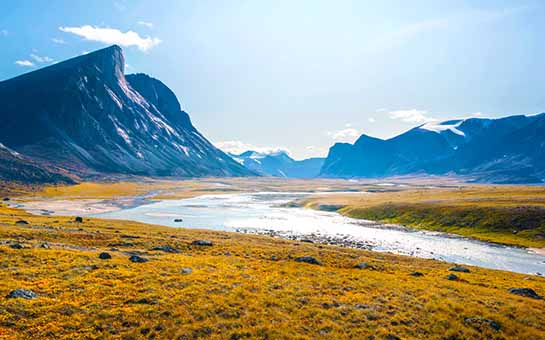With just 37,000 residents occupying over 700,000 square miles, Nunavut is one of the most sparsely populated places on the planet. But don’t let that lead you to believe there’s nothing to do here. Over 134,000 people visit Nunavut each year for a variety of reasons, with many of them arriving on cruise ships.
If Nunavut is on your list to visit, read on. But first, make sure you’re aware of the travel medical insurance you should get.
Travel Medical Insurance for Travelers visiting Nunavut – FAQs
Nunavut is an extremely remote territory, so any medical issue may be extremely expensive to treat. It is important for every visitor to have travel medical insurance that can cover them here.
Do I need travel medical insurance for Nunavut?
The Canadian government does not require foreign visitors to have travel medical insurance, but as far as your safety is concerned, it should be considered a necessity. It may be the only way you can get affordable treatment for unexpected illnesses or injuries in many parts of Nunavut.
Why buy travel medical insurance before visiting Nunavut?
Nunavut has few roads, and very few hospitals. There is a high probability that any major medical issue will require emergency medical evacuation. The cost for this in a remote location can easily surpass $250,000. Since most people cannot afford to pay this on their own, they should have travel medical insurance that can cover it.
Please keep in mind that much of Nunavut is above the Arctic Circle, and thus you will be subject to any Arctic region exclusions of your insurance plan while in that region.
Nunavut’s Most Popular Activities
Going on a Cruise
Nearly one in five recreational visitors to Nunavut arrive via cruise ships. These Arctic cruises typically navigate amazing routes like the Northwest Passage, Arctic Bay, Cambridge Bay, and other top-of-the-world locations, often breaking through ice along the way. Once arriving in Nunavut, you may have to take a smaller boat to reach land. As of this writing, Nunavut does not have any deepwater ports.
Hunting Big Game
The untouched wilderness of Nunavut makes it a world-class hunting destination. You can hire a guide to hunt polar bears, muskoxen, barren-ground caribou, walrus, and even wolves. Please keep in mind that proper Arctic survival skills, physical strength, and stamina are necessary if you want to hunt here.
Taking a Hike
The open tundra of Nunavut is unlike many other places on earth, and one of the best ways to explore it is on foot. Auyuittuq National Park is one of the most popular hiking destinations, as it features the tallest vertical cliff face in the world (4,101 feet), making it very appealing for rock climbers as well. The Cambridge Bay area of Victoria Island is popular with hikers as well.
Touring the Sinaaq
“Sinaaq” is the Inuktitut word for floe edge, which is a drifting chunk of sea ice up to six miles in width. You can take a floe edge tour in the spring and summer. An experienced local guide will lead you to views of a natural spectacle where walruses, seals, narwals, belugas, and even polar bears gather at the ice’s edge. It’s an incredible experience that you just can’t get in many other parts of the world.
Seeing Iqaluit
Iqaluit is the capital of Nunavut and the territory’s only city. This community of 7,000 offers several attractions including the Nunavut Legislative Assembly building with its remarkable Inuit art, Sylvia Grinnell Territorial Park with its river and scenic waterfalls, and the Nunatta Sunakkutaangit Museum with a significant collection of Arctic and Inuit artifacts and other objects.
Key Guidelines for Visitors to Nunavut
Getting to Nunavut
There are no roads that link Nunavut to the outside world, so arriving by air is the only practical option. You can take a regularly scheduled flight to Iqaluit and other locations from Canadian cities such as Ottawa, Montreal, Edmonton, Calgary, and Winnipeg.
Local Transportation
Perhaps “local” isn’t the right word, as Nunavut is incredibly large. In fact, if it was a country, it would be the 15th largest in the world. Despite this, there are fewer than 600 miles of roads in the whole territory. You can drive local roads within towns and communities, but the only reasonable option for travel between communities is typically by chartered flight or ship.
Communication
Cellphone service and internet are only available in select communities in Nunavut, and international phones will not always work here. Contact your mobile phone provider for options. Other communication methods include limited payphone access in some communities, as well as HF radio and satellite phone service in some remote communities and wilderness lodges.
Language
Inuktitut is the native language of the majority of Nunavut residents. And while most of them do speak English as well (and possibly French), this is not a guarantee in more remote communities. Most signage in the territory is listed in Inuktitut, English, and French. But once again, only Inuktitut signage is posted in some areas.
Weather
Nunavut has a subarctic and tundra climate. The summers here are short and very cool, and the winters are long and extremely cold. Always pack clothing that is suitable for an Arctic climate when visiting here, as the temperature can be below freezing even during the height of summer. In the winter, only clothing that is suitable to an Arctic expedition will be suitable for extended periods outdoors.
Before You Visit Nunavut – Do This
- Contact your mobile phone provider to see what kind of service you can access in case of emergencies.
- Shop for travel medical insurance .
- Make sure that the insurance coverage you purchase can cover you while you are in the locations you’re planning to visit, and taking part in your planned activities.
